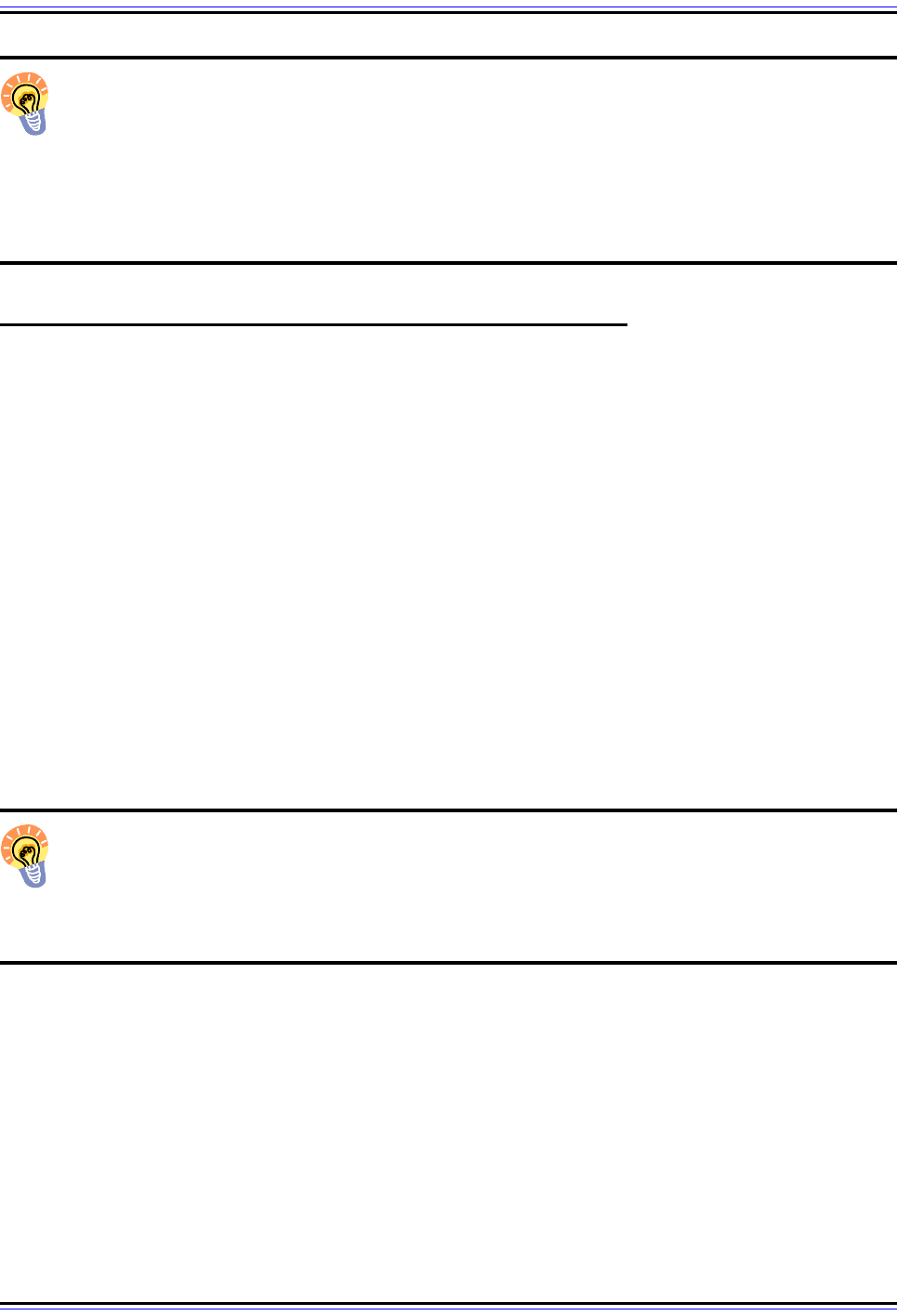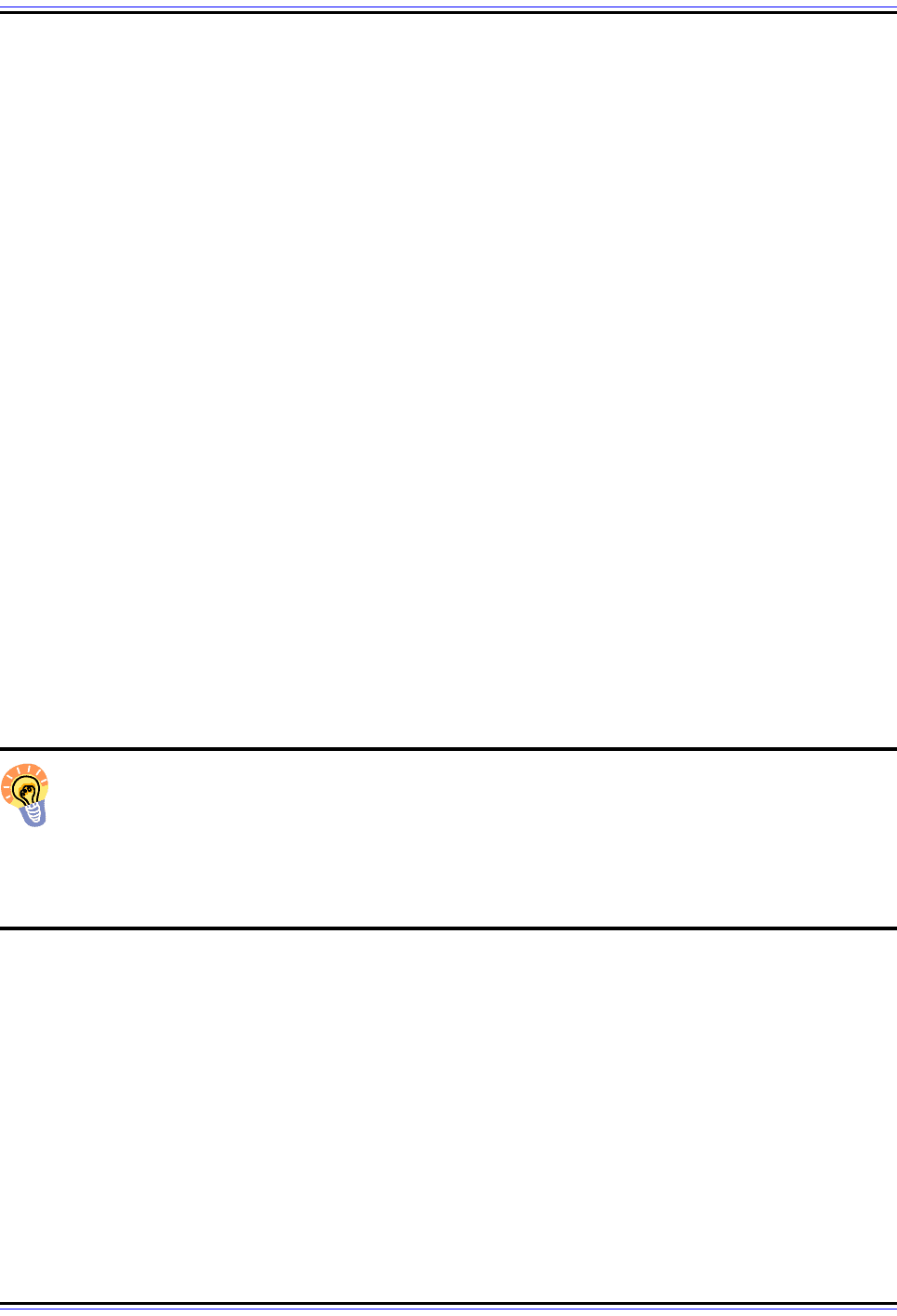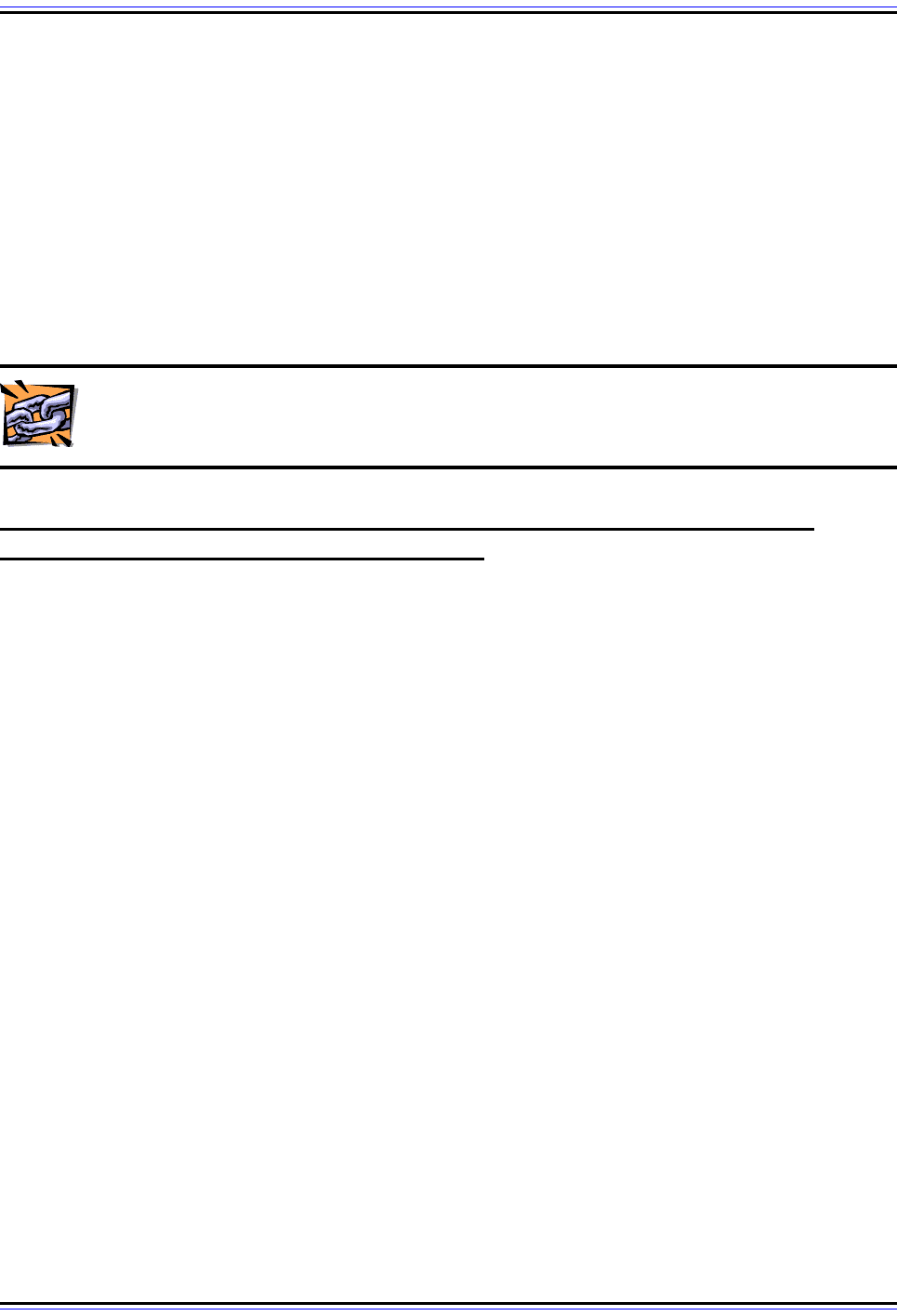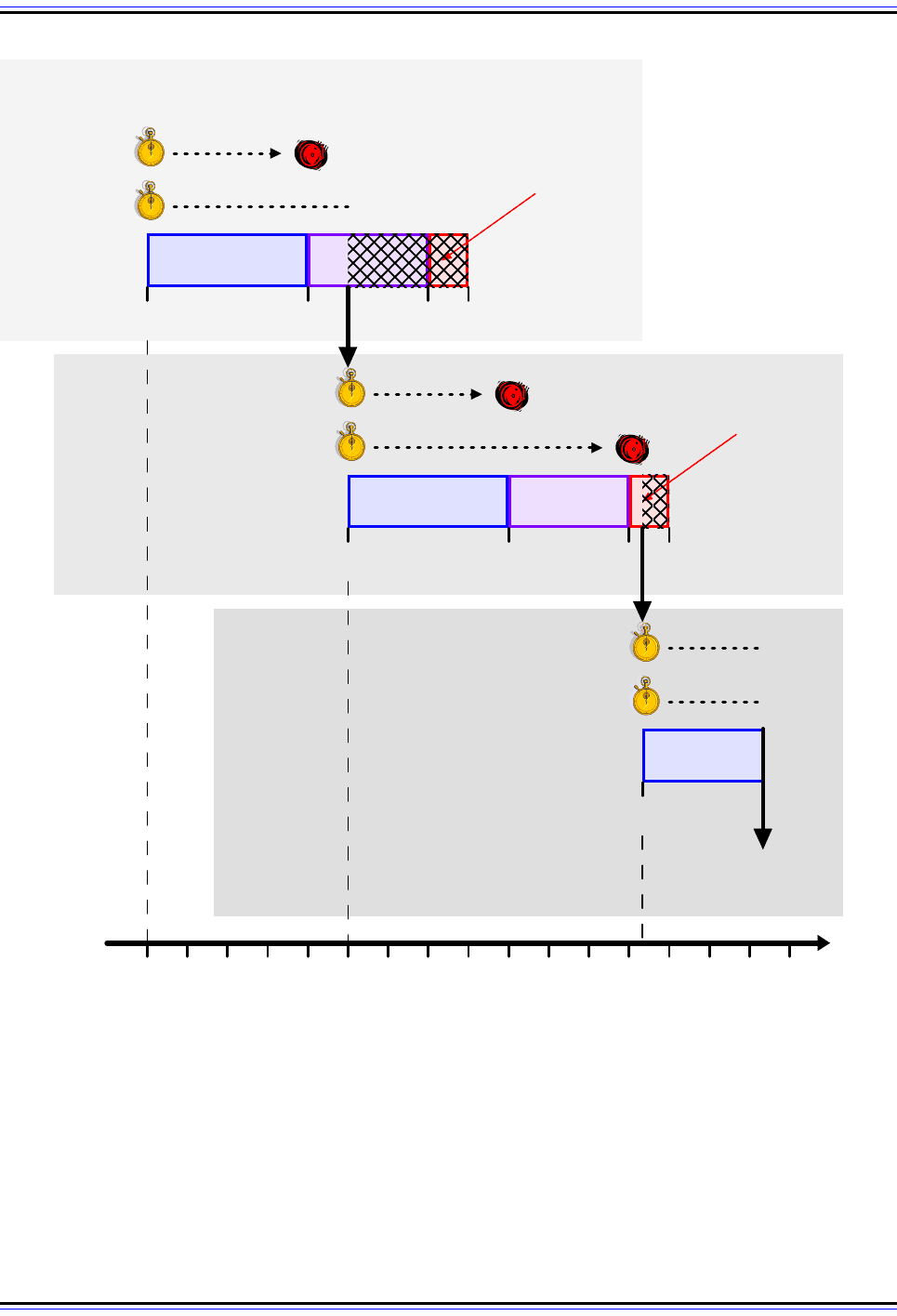Charles M. Kozierok The TCP-IP Guide
Подождите немного. Документ загружается.


The TCP/IP Guide - Version 3.0 (Contents) ` 1131 _ © 2001-2005 Charles M. Kozierok. All Rights Reserved.
DHCP Address Assignment and Dynamic Address Allocation and
Management
The Dynamic Host Configuration Protocol (DHCP) was created as an extension of the older
Boot Protocol (BOOTP). The first word in “DHCP” describes the most important new
capability that was added to BOOTP: the ability to assign IP addresses dynamically. Moving
from a static to a dynamic address allocation model dramatically changes the way we deal
with IP addresses in DHCP. Host configuration is transformed from a simple way to tell a
host what its address and other parameters are, to a complete tool for managing IP
addresses in an organization.
In this section I begin my detailed look at DHCP by describing the concepts behind DHCP
address assignment and leases. I begin with a look at how DCHP address assignment
works, and a description of the three DHCP address allocation mechanisms. I then delve
into DHCP leases and the policies and techniques used to decide how to implement DHCP
leasing. I provide an overview of the lease “life cycle” from start to finish, and describe the
two DHCP lease timers that help control the process. Finally, I describe DHCP lease
address pools and ranges and the general concepts behind address management.
DHCP Address Assignment and Allocation Mechanisms
The two main functions of the Dynamic Host Configuration Protocol are to provide a
mechanism for assigning addresses to hosts, and a method by which clients can request
addresses and other configuration data from servers. Both functions are based on the ones
implemented in DHCP's predecessor, BOOTP, but the changes are much more significant
in the area of address assignment than they are in communication. It makes sense to start
our look at DHCP here, since this will naturally lead us into a detailed discussion of defining
characteristic of DHCP: dynamic addressing.
DHCP Address Allocation Mechanisms
Providing an IP address to a client is the most fundamental configuration task performed by
a host configuration protocol. To provide flexibility for configuring addresses on different
types of clients, the DHCP standard includes three different address allocation
mechanisms:
☯ Manual Allocation: A particular IP address is pre-allocated to a single device by an
administrator. DHCP only communicates the IP address to the device.
☯ Automatic Allocation: DHCP automatically assigns an IP address permanently to a
device, selecting it from a pool of available addresses.
☯ Dynamic Allocation: DHCP assigns an IP address from a pool of addresses for a
limited period of time chosen by the server, or until the client tells the DHCP server that
it no longer needs the address.
I don't really care for the names “automatic” and “dynamic” allocation, because they don't
do a good job of clearly conveying the differences between these methods. Both can be
considered “automatic” because in each the DHCP server assigns an address with no

The TCP/IP Guide - Version 3.0 (Contents) ` 1132 _ © 2001-2005 Charles M. Kozierok. All Rights Reserved.
administrator intervention required. The real difference between them is only in how long
the IP address is retained, and therefore, whether a host's address varies over time. I think
better names would be “static/permanent automatic allocation” and “dynamic/temporary
automatic allocation”. But then, nobody really cares much what I think. ☺
Regardless of what you call them, all three of these methods exist for configuring IP hosts
using DHCP. It is not necessary for an administrator to choose one over the others. Instead,
he or she will normally combine the methods, using each for the devices where it makes the
most sense.
Manual Allocation
Manual allocation is the simplest method, and is equivalent to the method BOOTP uses for
address assignment. Each device has an address that an administrator gives it ahead of
time, and all DHCP does is look up the address in a table and send it to the client for which
it is intended. This technique makes the most sense for devices that are “mainstays” of the
network, such as servers and routers. It is also appropriate for other devices that for
whatever reason must have a stable, permanent IP address.
Okay, now here's a fair question you might have. DHCP acts basically like BOOTP in the
case of manual allocation. But BOOTP was created for devices that needed help with
configuration. Servers and routers are complex devices with their own internal storage, and
obviously don't need a DHCP server to tell them their IP address like a diskless workstation
does, so why bother using DHCP for them at all?
Well, in fact, you could just manually assign the address to the device directly and tell
DHCP to ignore those addresses. However, using DHCP for manual assignments yields a
different benefit: an administrative one. It keeps all the IP address information centralized
in the DHCP address database, instead of requiring an administrator to go from machine to
machine checking addresses and ensuring there are no duplicates. Updates can also be
made in a single place as well.
Dynamic Allocation
While manual allocation is possible in DHCP, dynamic allocation is its real “raison d'être”.
An administrator sets up a pool (usually a range or set of ranges) of IP addresses that are
available for use. Each client that is configured to use DHCP contacts the server when it
needs an IP address. The server keeps track of which IP addresses are already assigned,
and leases one of the free addresses from the pool to the client. The server decides the
amount of time that the lease will last. When the time expires, the client must either request
permission to keep using the address (renewing the lease) or must get a new one. This
matter of leases and how they are handled will be the subject of most of the rest of this
section.
Dynamic allocation is the method used for most client machines in modern DHCP-enabled
IP internetworks. It offers numerous benefits, including the following:

The TCP/IP Guide - Version 3.0 (Contents) ` 1133 _ © 2001-2005 Charles M. Kozierok. All Rights Reserved.
☯ Automation: Each client can be automatically assigned an IP address when it is
needed with no intervention and no need for an administrator to manually decide
which address goes with which client.
☯ Centralized Management: All the IP addresses are managed by the DHCP server.
An administrator can easily look to see which devices are using which addresses and
perform other network-wide maintenance tasks.
☯ Address Reuse and Sharing: By limiting the amount of time that each device holds
an IP address, the DHCP server can ensure that the pool of IP addresses is only used
by devices actively using the network. After a period of time, addresses no longer
being used are returned to the pool, allowing other devices to use them. This allows an
internetwork to support a total number of devices larger than the number of IP
addresses available, as long as not all the devices connect to the internetwork at the
same time.
☯ Portability and Universality: BOOTP (and DHCP manual allocation) both require
that the DHCP server “know” the identity of each client that connects to it, so the
server can find the client's assigned address. With dynamic allocation, there are no
predefined allocations, so any client can request an IP address. This inherently makes
dynamic allocation the ideal choice for supporting mobile devices that travel between
networks.
☯ Conflict Avoidance: Since IP addresses are all assigned from a pool that is managed
by the DHCP server, IP address conflicts are avoided.
The last point, of course, assumes that all the clients use DHCP. The administrator must
ensure that the address pool is not used by non-DHCP devices. More about this in a later
topic on DHCP address ranges and address management.
Automatic Allocation
The third option, automatic allocation, can be used in cases where there are enough IP
addresses for each device that may connect to the network, but where devices don't really
care what IP address they use. Once an address is assigned to a client, that device will
keep using it. Automatic allocation can be considered a “special case” of dynamic
allocation: it is essentially dynamic allocation where the time limit on the use of the IP
address by a client (the lease length) is “forever”.
In practice, automatic allocation is not used nearly as much as dynamic allocation, for a
simple reason: automatically assigning an IP address to a device permanently is a risky
move. Most administrators feel it is better to use manual allocation for the limited number of
machines that really need a permanent IP address assignment, and dynamic addressing
for others. We'll discuss this more in the next topic.

The TCP/IP Guide - Version 3.0 (Contents) ` 1134 _ © 2001-2005 Charles M. Kozierok. All Rights Reserved.
Key Concept: DHCP defines three basic mechanisms for address assignment.
Dynamic allocation is the method most often used, and works by having each client
lease an address from a DHCP server for a period of time; the server chooses the
address dynamically from a shared address pool. Automatic allocation is like dynamic
allocation but the address is assigned permanently instead of being leased. Manual
allocation pre-assigns an address to a specific device, just as BOOTP does, and is normally
used only for servers and other permanent, important hosts.
DHCP Leases, Lease Length Policies and Management
Of the three address allocation methods supported by DHCP, dynamic address allocation is
by far the most popular and important. The significance of the change that dynamic
addressing represents to how IP addresses are used in TCP/IP can be seen in the
semantics of how addresses are treated in DHCP. Where conventionally a host was said to
own an IP address, when dynamic address allocation is used, hosts are said instead to
lease an address.
The notion of a “lease” conveys very accurately the difference between dynamic allocation
and the other types. A host no longer is strictly “entitled” to a particular address, with a
server merely telling it what the address is. In DHCP, the server remains the real owner of
all the IP addresses in the address pool, and merely gives permission for a client to use the
address for a period of time. The server guarantees that it will not try to use the address for
another client only during this time. The client is responsible for taking certain actions, as
we will see later in this section, if it wants to continue using the address. If it does not
successfully reacquire permission for using the address after a period of time, it must stop
using it, or risk creating an IP address conflict on the network.
Key Concept: DHCP’s most significant new feature is dynamic allocation, which
changes the way that IP addresses are managed. Where in traditional IP each
device owns a particular IP address, in DHCP the server owns all the addresses in
the address pool, and each client leases an address from the server, usually only for a
limited period of time.
DHCP Lease Length Policy and Choosing Lease Durations
When dynamic address allocation is used, the administrator of the network must provide
parameters to the DHCP server to control how leases are assigned and managed. One of
the most important decisions to be made is the lease length policy of the internetwork: how
long the administrator wants client leases to last. There of course is no “right answer”—the
right lease length interval depends on the network, the server, and the clients. The choice of
lease time, like so many other networking parameters, boils down to a trade-off between
stability and allocation efficiency.

The TCP/IP Guide - Version 3.0 (Contents) ` 1135 _ © 2001-2005 Charles M. Kozierok. All Rights Reserved.
The primary benefit of using long lease times is that the addresses of devices are relatively
stable. A device doesn't have to worry about its IP address changing all the time—and
neither does its user. This is a significant advantage in many cases, especially when it is
necessary for the client to perform certain server functions, accept incoming connections,
or use a DNS domain name (ignoring for the moment dynamic DNS capabilities). In those
situations, having the IP address of a device moving all over the place can cause serious
complications.
The main drawback of using long leases is that they substantially increase the amount of
time that an IP address, once no longer needed, is “tied up” before it can be reused. In the
worst case scenario, the amount of “wasted time” for an allocation can be almost as long as
the lease itself. If we give a device a particular address for six months and after two weeks
the device is shut down and no longer used, the IP address that it was using is still
“unavailable” for another five and a half more months.
For this reason, many administrators prefer to use short leases. This forces a client to
continually renew the lease as long as it needs it. When it stops asking for permission
again, the address is quickly put back into the pool. This makes shorter leases a better idea
in environments where the number of addresses is limited and must be conserved. The
drawback, of course, is the opposite of the benefit of long leases: constantly-changing IP
addresses.
Common Lease Durations
The administrator need not pick from “short” and “long” lease durations. He or she can
“compromise” by choosing a number that best suits the network. Some examples of lease
times and the reasoning behind them:
☯ One Hour Or Less: Ensures maximum IP address allocation efficiency in a very
dynamic environment where there are many devices connecting and disconnecting
from the network, and the number of IP addresses is limited.
☯ One Day: Suitable for situations where “guest” machines typically stay for a day, to
increase IP efficiency when many employees work part-time, or otherwise to ensure
that every day each client must ask again for permission to use an address.
☯ Three Days: This is the default used by Microsoft. This alone makes it a popular
choice.
☯ One Week: A reasonable “compromise” between the shorter and longer times.
☯ One Month: Another “compromise”, closer to the longer end of the lease time range.
☯ Three Months: Provides reasonable IP address stability so that addresses don't
change very often in reasonably static environments. Also a good idea if there are
many IP addresses available and machines are often turned off for many days or
weeks at a time. May be used in a university setting to ensure that IP addresses of
returning students are maintained over the summer recess.
☯ One Year: An approximation of an “infinite” lease; see below.

The TCP/IP Guide - Version 3.0 (Contents) ` 1136 _ © 2001-2005 Charles M. Kozierok. All Rights Reserved.
Assigning Lease Length By Client Type
In fact, not only is the administrator not restricted to a limited number of possible lease
durations, it is not necessary for the administrator to choose a constant lease length policy
for all clients. Depending on the capabilities of the DHCP server, an administrator may
select different lease lengths for certain clients than others. For example, the administrator
may decide to use long leases for desktop computers that are permanently assigned to a
particular subnet and not moved, and a pool of short-leased addresses for notebooks and
“visitors”. In some DHCP implementations this can be done by assigning clients to particular
“classes”. Of course, this requires more work (and may even require multiple servers.)
Factoring Lease Renewal Into Lease Length Selection
In selecting a lease time policy, the administrator must also bear in mind that by default,
after half the length of a lease, the client will begin attempting to renew the lease. This may
make it more advisable to use a longer lease time, to increase the amount of time between
when a client tries to renew the lease and when the lease expires. For example, in a
network with a single DHCP server, an administrator may want to use leases no shorter
than eight hours. This provides a four-hour “window” for maintenance on the server without
leases expiring.
When a lease is very short, such as minutes or hours, it will typically expire when a client
machine is turned off for a period of time, such as overnight. Longer leases will persist
across reboots. The client in this case will still contact the DHCP server each time it is
restarted to reallocate the address—confirm that it may continue using the address it was
assigned.
Key Concept: A key decision that a network administrator using DHCP must make
is what the network’s lease length policy will be. Longer leases allow devices to avoid
changing addresses too often, while shorter leases are more efficient in terms of
reallocating addresses that are no longer required. An administrator can choose from a
variety of different lease times, and may choose longer leases for some devices than for
others.
Issues With "Infinite" Leases
In addition to choosing a particular lease length number, it is possible to specify an “infinite”
lease length duration for certain clients. This effectively turns dynamic allocation into
automatic allocation for a particular client. As I said in the previous topic, however, this is
generally not done. The reason is that an infinite lease never expires, and as the old saw
goes, “never is a long time”. ☺
Permanently assigning an IP address from a pool is a somewhat “risky” move, because
once assigned, if anything occurs that causes that address to be no longer used, it can
never be recovered. A worst-case scenario would be a visitor to a company site who plugs

The TCP/IP Guide - Version 3.0 (Contents) ` 1137 _ © 2001-2005 Charles M. Kozierok. All Rights Reserved.
a notebook computer in to the network to check e-mail or transfer a file. If that machine is
assigned an IP address using automatic allocation, the visitor will “take it with him” when he
leaves. Obviously, not a great idea.
For this reason, most administrators prefer to use dynamic allocation instead, with
addresses set to a very long time frame, such as a year or two years. This is considered
“near enough to infinity” that it approximates a permanent assignment, but allows an IP
address to eventually be recovered if a device for whatever reason stops using it. In such a
policy, anything that really, truly needs a permanent assignment is given an address using
manual assignment, which requires a conscious decision to dedicate the address to a
particular device.
Related Information: For a little more information related to lease length
selection, see the topic on DHCP server implementation problems and issues.
DHCP Lease "Life Cycle" Overview (Allocation, Reallocation, Renewal,
Rebinding and Release) and Lease Timers
The use of dynamic address allocation in DHCP means a whole new way of thinking about
addresses. A client no longer owns an address, but rather leases it. This means that when
a client machine is set to use DHCP dynamic addressing, it can never assume that it has an
address on a permanent basis. Each time it powers up, it must engage in communications
with a DHCP server to begin or confirm the lease of an address. It also must perform other
activities over time to manage this lease and possibly terminate it.
The DHCP Lease "Life Cycle"
Calling dynamic address assignments leases is a good analogy, because a DHCP IP
address lease is similar to a “real world” lease in a number of respects. For example, when
you rent an apartment, you sign the lease. Then you use the apartment for a period of time.
Typically, assuming you are happy with the place, you will renew the lease before it expires,
so you can keep using it. If by the time you get near the end of the lease the owner of the
apartment has not allowed you to renew it, you will probably lease a different apartment to
ensure you have somewhere to live. And if you decide, say, to move out of the country, you
may terminate the lease and not get another at all.
DHCP leases follow a similar lease “life cycle”, which generally consists of the following
phases:
☯ Allocation: A client begins with no active lease, and hence, no DHCP-assigned
address. It acquires a lease through a process of allocation.
☯ Reallocation: If a client already has an address from an existing lease, then when it
reboots or starts up after being shut down, it will contact the DHCP server that granted
it the lease to confirm the lease and acquire operating parameters. This is sometimes
called reallocation; it is similar to the full allocation process but shorter.

The TCP/IP Guide - Version 3.0 (Contents) ` 1138 _ © 2001-2005 Charles M. Kozierok. All Rights Reserved.
☯ Normal Operation: Once a lease is active, the client functions normally, using its
assigned IP address and other parameters during the “main part” of the lease. The
client is said to be bound to the lease and the address.
☯ Renewal: After a certain portion of the lease time has expired, the client will attempt to
contact the server that initially granted the lease, to renew the lease so it can keep
using its IP address.
☯ Rebinding: If renewal with the original leasing server fails (because, for example, the
server has been taken offline), then the client will try to rebind to any active DHCP
server, trying to extend its current lease with any server that will allow it to do so.
☯ Release: The client may decide at any time that it no longer wishes to use the IP
address it was assigned, and may terminate the lease, releasing the IP address. Like
the apartment-renter moving out of the country, this may be done if a device is moving
to a different network, for example. Of course, unlike DHCP servers, landlords usually
don't let you cancel a lease at your leisure, but hey, no analogy is perfect.
Figure 259 illustrates the DHCP life cycle using an example that spans three leases.
Renewal and Rebinding Timers
The processes of renewal and rebinding are designed to ensure that a client's lease can be
extended before it is scheduled to end, so no loss of functionality or interruption occurs to
the user of the client machine. Each time an address is allocated or reallocated, the client
starts two timers that control the renewal and rebinding process:
☯ Renewal Timer (T1): This timer is set by default to 50% of the lease period. When it
expires, the client will begin the process of renewing the lease. It is simply called “T1”
in the DHCP standards.
☯ Rebinding Timer (T2): This timer is set by default to 87.5% of the length of the lease.
When it expires, the client will try to rebind, as described above. It is given the snappy
name “T2” in the DHCP standards.
Naturally, if the client successfully renews the lease when the T1 timer expires, this will
result in a “fresh lease”, and both timers will be reset. T2 only comes into play if the renewal
is not successful. It is possible to change the amount of time to which these timers are set,
but obviously T1 must expire before T2, which must in turn expire before the lease itself
ends. These usually are not changed from the default, but may be modified in certain
circumstances.
Key Concept: DHCP leases follow a conceptual life cycle. The lease is first
assigned to the client through a process of allocation; if the device later reboots it will
reallocate the lease. After a period of time controlled by the renewal timer (T1), the
device will attempt to renew its lease with the server that allocated it. If this fails, the
rebinding timer (T2) will go off and the device will attempt to rebind the lease with any
available server. The client may also release its IP address if it no longer needs it.

The TCP/IP Guide - Version 3.0 (Contents) ` 1139 _ © 2001-2005 Charles M. Kozierok. All Rights Reserved.
Figure 259: DHCP “Life Cycle” Example
In this example, the initial lease has a duration of eight days and begins at Day 0. The T1 and T2 timers are
set for 4 days and 7 days respectively. When the T1 timer expires the client enters the renewal period, and
successfully renews at Day 5 with a new 8-day lease. When this second lease’s T1 timer expires, the client is
unable to renew with the original server. It enters the rebinding period when its T2 timer goes off, and is
granted a renewed 8-day lease with a different server. Three days into this lease it is moved to a different
network and no longer needs its leased address, so it voluntarily releases it.
Normal
Operation
Renewal
Period
0
Allocation, 8-Day Lease
Start Time rs
Renewal Timer
T1: 50% (4 Days)
Rebinding
Period
478
Renewal, 8-Day Lease
Re-start Timers
Normal
Operation
Renewal
Period
0
Rebinding
Period
478
Lease Day:
Rebinding, New 8-Day Lease
Start Time rs
Normal Operation ...
0 3
R
ebinding Timer
2: 87.5% (7 Days)
Renewal Timer
T1: 50% (4 Days)
Rebinding Timer
T2: 87.5% (7 Days)
Renewal Timer T1:
50% (4 Days)
Rebinding Timer T2:
87.5% (7 Days)
Lease Day:
Lease Day:
Release
(Termination)
0 1 2 3 4 5 6 7 8 9
10 11 12 13 14 15 16
Timeline (Days)

The TCP/IP Guide - Version 3.0 (Contents) ` 1140 _ © 2001-2005 Charles M. Kozierok. All Rights Reserved.
The lease life cycle is described in the DHCP standards in the form of states that the client
moves through as it acquires a lease, uses it, and then either renews or ends it. The next
section on DHCP configuration describes these states and the specific exchanges of
messages between a client and server to accomplish different lease activities.
DHCP Lease Address Pools, Ranges (Scopes) and Address Management
Simpler host configuration methods such as BOOTP (or DHCP manual allocation for that
matter) associate a single IP address with each client machine. DHCP dynamic addressing
removes this one-to-one correspondence, in favor of flexible address mapping to clients on
an “as needed basis”. The clients no longer own the addresses but lease them from the true
owner, the server. Obviously, then, a primary job of both a DHCP server and the adminis-
trator of that server is to maintain and manage these client addresses.
Address Pool Size Selection
The set of all addresses that a DHCP server has available for assignment is most often
called the address pool. The first issue related to address management is ensuring that the
address pool is large enough to serve all the clients that will be using the server. The
number of addresses required depends on a number of factors:
☯ Number Of Clients: Obviously.
☯ Stability and Frequency of Use Of Clients: If most clients are left on and connected
to the network all the time, you will probably need to plan on an address for each one.
In contrast, if you are serving part-time employees, or consultants who frequently
travel, you can get away with sharing a smaller number of addresses.
☯ Consequences Of Over-Allocation: If having certain clients be unable to get a free
address is a problem, you need to more carefully manage the address pool to ensure
that you don't run out. If having a client not get an address is never acceptable, make
sure you have as many or more addresses as clients.
I'm sure you've probably noticed that these issues are similar to those that I raised in
discussing lease lengths earlier in this section. In fact, the two matters are intimately
related. Generally speaking, having more addresses gives the administrator the “luxury” of
using longer leases. If you are short on addresses you probably need to use shorter leases
to reduce the chances of any unused addresses continuing to be allocated to devices not
needing them.
Lease Address Ranges (Scopes)
In its simplest form, the address pool takes the form of a list of all addresses that the DHCP
server has reserved for dynamic client allocation. Along with each address, the server
stores certain parameters, such as a default lease length for the address and other configu-
ration information to be sent to the client when it is assigned that address (for example, a
subnet mask and the address of a default router). All of this data is stored in a special
database on the server.
